#House Farnese
Text

Clelia Farnese (1552/1556 – 11 September 1613), was an Italian noblewoman, member of the House of Farnese, and by her two marriages Marchioness of Civitanova and Lady of Sassuolo. According to contemporaries, she was one of the most beautiful women of her time. She ruled as regent of the Lordship of Sassuolo during the absence of her second spouse Marco III Pio di Savoia, Lord of Sassuolo.
30 notes
·
View notes
Text

Villa Farnese, Caprarola, Viterbo, Northern Lazio, Italy
#art#design#architecture#history#style#luxury lifestyle#luxury house#luxury home#villa#villa farnese#renaissance#pentagonal#fortress#viterbo#lazio#caprarola#16th century
3K notes
·
View notes
Text

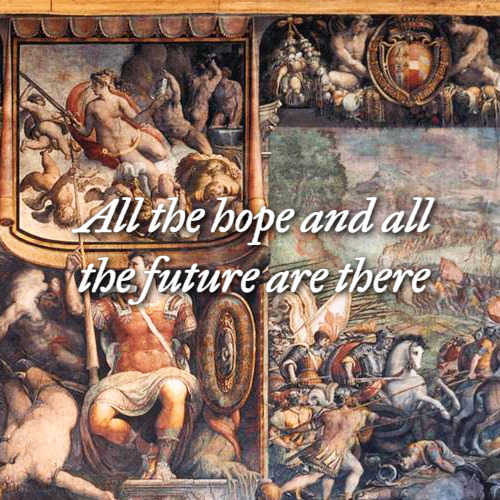
THE ROYAL BAPTISM AT THE PALAZZO FARNESE
Rome, 29 December 1869
I have just left the Farnese Palace, and I really believe that one can say without exaggeration: Naples is no longer in Naples; it is all in Rome today.
It is doubtful indeed that, even in the middle of his capital, Francis II would have seen himself surrounded by a crowd more numerous and better representing, not only the elite, but all the ranks of the nation of which he is the legitimate sovereign.
Certainly more magnificent pomp could have shone in Naples around the royal cradle. But first of all, could the young princess have hoped to have more august godparents before God and at her entry into the Christian life? The Holy Father, the first and greatest of the world's monarchs, the very Vicar of Our Lord Jesus Christ, and in whom the crown of suffering and misfortune heroically borne is added to the majesty of the tiara and the halo of sanctity; The Empress of Austria, who occupied the throne of the Habsburgs and whose sister was that great and pious Queen whom the people, anticipating in some way the judgment of the Church, like to proclaim "the Saint".
(...) The birth of the princess was a universal joy in the kingdom, and for two or three days hundreds of the most eminent people flocked to Rome. At the same time all the trains brought deputations chosen by each province and which the Piedmontese government allowed to pass, for want of being able to oppose a movement which was the expression of popular feeling.
From noon onwards, the vast halls of the Farnese Palace, which is one of the wonders of Rome and has few rivals in Europe, were filled with an enormous audience, composed almost exclusively of Neapolitans. Hardly the Senator of Rome and some Roman princes had been invited. The King, who, like all Bourbons, identifies his family with his country, had wished to be surrounded, with very few exceptions, only by his subjects and servants.
(...) With a delicacy worthy of his great heart, the King had asked the Bishops of the monarchy present in Rome to abstain from appearing at the ceremony: it was not necessary that a mark of religious fidelity should excite against the Episcopate of Naples the passions already so violent of Unitarianism and of the Revolution. On the other hand, fourteen Cardinals had come to pay homage to the majesty of right and wrong.
The number of young men mixed with the defenders who had been whitened in the service of the monarchy was particularly gratifying. After so long an exile, and in the midst of the temptations and seductions which are not spared, the presence and confidence of this generation, which is only just being born into public life, is a most favourable omen. Tradition is perpetuated, and hereditary devotion offers the Crown renewed phalanxes.
All the hope and all the future are there.
The Holy Father was represented by Cardinal Antonelli; the Empress Maria Anna, the godmother, was represented by Her Majesty the Empress [Elisabeth] of Austria, brilliant in beauty, grace, elegance and dignity. The procession of the princes was composed of H. M. the King of the Two Sicilies, H.R.H. the Duke and Duchess of Parma, H.I.H. and RR. the Grand Duke and Grand Duchess of Tuscany, H.R.H. the Count and Countess of Caserta, the Count and Countess of Girgenti, the Duke and Duchess of Alençon, the Duke of Bari and Princess Maria Immacolata, the Count and Countess of Trapani, the Prince their son and the two Princesses their daughters, the Prince of Hohenzollern.
The altar stood in the room decorated with the magnificent paintings of Salviati.
The young princess was carried on the arms of the Duchess of San Cesario. It was a touching honour for the illustrious and courageous Grand Mistress of the Palace, whose name is inseparably linked to that of the heroine of Gaeta and who deserved to receive the medal of that forever memorable siege; it was a touching honour for her to hold before the sacred font the royal child whose birth has just thrown a lightning bolt of happiness on the fortunes she has nobly shared.
S. Cardinal Patrizi performed the ceremonies and gave the young princess the names of Christina-Pia-Maria-Anna-Elisabetha-Natalina-Ephisa. The Neapolitan nurse in the magnificent costume of the women of her country, from the mountains of Avellino, was noted with interest near the font. These national clothes had a charm and a high significance in the midst of the brilliant finery of the great ladies and the insignia of the court figures.
The princess carried the magnificent christening gown, made of white lace, a gift from three hundred Neapolitan ladies, a masterpiece of taste and a guarantee of fidelity.
After the ceremony, the procession reformed. The Empress, the King, the Princes and Princesses went to the salons. The new Christian was brought to her august mother, whose emotion was deep. The Queen, with tears in her eyes, instructed the Duchess of San Cesario to thank all the faithful Neapolitans who had given, on this occasion, proof of a devotion that survives time, trials and persecutions. The Queen's emotion was so strong that duchess had to withdraw so as not to prolong its duration.
And, in fact, nothing honours a people and touches the hearts of sovereigns like these testimonies of a constancy above all perils, all perils and all sufferings.
The King was radiant with happiness. After ten years of proscription and in the midst of the joys of fatherhood, to find near him the servants who had been the companions of his misfortunes; to see a new generation rising up in the cult of right and duty; to receive the wishes of an entire people who aspire to become free again and to reconquer their nationality and their dynasty: what a consolation, and above all what hope!
Here, then, is at last a dawn of prosperity rising over the House of Bourbon and the kingdom of Naples! It is the harbinger of an even more beautiful day; it is the sign of a forthcoming triumph of good Law and Justice.
De Riancey, Henri (1870). Lettres sur Rome (Translation done by DeepL. Please keep in mind that in a machine translation a lot of nuance may/will be lost)
#this man was more optimist about the future of the bourbons than the bourbons themselves#the pictures are the salviati paintings in the palazzo farnese that de riancey mentions btw!#princess maria cristina of bourbon-two sicilies#queen marie sophie of the two sicilies#francesco ii of the two sicilies#empress elisabeth of austria#house of bourbon-two sicilies#on this day in history#long post
6 notes
·
View notes
Text

Margarita of Parma.
#italian aristocracy#margarita de parma#royal bastards#ducato di parma#casa farnese#casa de austria#house of habsburg#ducato di parma e piacenza#Margherita d'Austria#Margherita d'Asburgo#Casa d'Asburgo
3 notes
·
View notes
Note
Do you have any tips on studying the art of seduction or tapping into your sensuality as a woman? Books, movies, anything helps!
Rare topic of conversation alert but-
Forget men entirely. Tapping into your sensuality as a woman has nothing to do with men and everything to do with you and your love for yourself.
Date yourself. Court yourself. Move through life like you are in a relationship with you (because you are) and act accordingly. Treat yourself with care. Nourish your hair and skin and invest time + energy into making your mind and body feel good. Epsom salt baths, dancing, body oils, hair oils, buying yourself flowers, taking yourself on dates, meditation.
You can't be sensual if you're ignorant of and afraid of your own body. Familiarize yourself with it (stand naked in the mirror a lot, touch yourself non sexually a lot, study your own body a lot). You have to love your body and feel comfortable in your natural form. You have to feel confident and good both in and out of clothes.
That last part can intertwine with sexuality too. It's important to know what you like and what makes you feel good. It's healthy. Experimenting with self pleasure can help you learn a lot of things about yourself, some of them even non sexual.
Sensual means physically pleasing and it's related to the 5 senses, and taking the time to really indulge in those 5 senses will help you. We all know that things that are pleasing to the ear can have the power to relax us or turn us on, so listen to things that get your blood moving and make you feel warm. It could be asmr, it could be binaural beats, it could be a creator who reads stories and poems. I personally love to listen to Tom Hiddleston read poetry and short stories. He has a voice that is very audibly pleasing to me. Buy and wear scents that lift your mood, watch media or look at art that stirs up intense feelings. Indulge in touching things and things that feel good on your skin. Sleep naked, sit in the grass, walk on sand. Eat things that are very flavorful and juicy and messy lol. If you drink wine, I'd actually encourage you to research what kind of wine is best to drink with certain foods that really make flavors pop. Play music around the house, light scented candles or wax melts, give yourself massages. Just really indulge and take advantage of all of the senses that you can.
Look up sumrandomchick, zitacherry, and Anastasiamoongirl on tiktok
Movies/TV: kama sutra a tale of love, dangerous beauty (1998), The Borgias (Giulia Farnese and Lucrezia in particular), The Woman King, Moulin Rouge, Margarita With a Straw, The Handmaiden, She's Gotta Have It (2017), Belle de Jour (1967), Poor Things (I have yet to see this one but I have heard praises on its exploration of female sexuality). I personally don't want to recommend Memoirs Of A Geisha due to its wildly awful inaccuracies (so much so that the woman it's loosely based off of tried to sue the author I'm sure), however, if you take it with a grain of salt and have good discernment, there can be gems found in it.



243 notes
·
View notes
Text
Catholic Character Tournament
Current Bracket

All polls here (tagged #cct polls)
Round 5 (16 nominees) is Wednesday July 5 12 PST
Character Submission List:
(Note, not in the order in the bracket. They were randomized for the bracket) (crossed out means dead-dead)
*707/Luciel Choi (Mystic Messenger)
*Abuela Alma Madrigal (Encanto)
*Akane Kurashiki (Zero Escape)
*Amon from (Tokyo Ghoul)
*Angel (Buffy the Vampire Slayer and Angel the Series)
*Asia Argento (High School DxD)
Aslan from (Chronicles of Narnia)
*Aymeric de Borel (Final Fantasy 14)
*Aziraphale (Good Omens) (Disqualified) The Volturi
*Belizabeth Brassica (Dimension 20's A Crown of Candy)
*Bishop Raphaniel Charlock (Dimension 20 - the Ravening War)
*Blake Langermann (Outlast 2)
*Brother Cellanus (The Completely Unerotic Adventures of Brother Cellanus)
*Caesar Zeppeli (Jojo's Bizarre Adventure)
*Carlos Reyes (911 Lone Star)
*Carrie White (Carrie)
*Catherine of Aragon (SIX: the Musical)
*CC (Code Geass)
*Chrollo Lucilfer (Hunter x Hunter)
*Chuck E. Cheese
*Claude Frollo(The Hunchback of Notre Dame)
*Crowley (Good Omens) (Disqualified) Vanessa Ives replacement (Penny Dreadful)
Dana Scully (the X files)
Doomguy (Doom)
*Double (Skullgirls)
Doug Jones (The VelociPastor)
*Dracule Mihawk (One Piece)
*Duo Maxwell (Gundam Wing)
*Eddie Brock (Venom)
*Emilio Santoz from The Sparrow
Enrico Pucci (Jojo’s Bizarre Adventure)
*Farnese de Vandimion (Berserk)
*Father Alexander Anderson (Hellsing)
*Father Brown (Father Brown)
Father John Mulcahy (MASH)
Father Paul (Midnight Mass)
*Felicia Hardy/Black Cat (Spiderman)
Firestar (Warrior Cats)
*Flayn (Fire Emblem Three Houses)
*Frank Castle (Marvel)
Friar Tuck (Robin Hood)
*Gabriel (Ultrakill)
*Galahad (The Mechanisms)
*Gerard (Unholyverse)
Gloria Maria Ramirez Delgado-Pritchett (Modern Family)
Harrowhark Nonagesimus (The Locked Tomb)
*Helena Bertinlli (DC comics)
Hell boy (HellBoy)
Homura Akemi (Madoka Magica)
*Hot Pants (Jojo’s Bizarre Adventure)
*Ibara Shiozaki (My Hero Academia)
*Inori Yamabuki/Cure Pine (Fresh Precure)
Jason Todd (DC Comics)
*Javert (Les Miserables)
Jean Valjean (Les Misérables)
*Jeanne d'Arc (Alter) (Fate/Grand Order)
*Jesus (Jesus Christ Superstar)
*John "Soap" MacTavish (Call of Duty)
*John Gaius (The Locked Tomb)
*John Ward (FAITH)
*Johnathan (Shin Megami Tensei IV)
*Junk Rat (Overwatch)
*Justin Law (Soul eater)
*Kawabuchi Sentarou (Kids on the Slope)
Kaworu Nagisa (Neon Genesis Evangelion)
*Kirei Kotomine (Fate franchise)
Knuckes the Echidna (Sonic)
*Kristen Applebees (Dimension 20's Fantasy High)
*Kuroe (Magia Record)
Kurt Wagner/Nightcrawler (X-Men)
*Ky Kiske (Guilty Gear)
*Kyoko Sakura (Puella Magi Madoka Magica)
*Lady Rhea (Fire Emblem: Three Houses)
*Leliana (Dragon Age)
*Leon (8:11)
*Lestat de Lioncourt (The Vampire Chronicles)
*Libra (Fire Emblem: Awakening)
*Link (The Legend of Zelda)
*Louis de Pointe du Lac (Interview with the Vampire/The Vampire Chronicles)
*Luis Serra Navarro (Resident Evil)
Mac McDonald (It’s Always Sunny In Philadelphia)
Maddie Fitzpatrick (Suite Life of Zack and Cody)
*Marcy Park (The 25th Annual Putnam County Spelling Bee)
*Mark Heathcliff (The Mandela Catalogue)
Matt Murdock/Daredevil (Marvel)
*Mello (Death Note)
*Mercedes (Fire Emblem: Three Houses)
*Michael Carpenter (Dresden Files)
*Michael Corleone (The Godfather)
Miles Morales/Spider-Man
*Nate Ford (Leverage)
Nicholas D. Wolfwood (Trigun)
*Nico di Angelo (Percy Jackson)
*Ocean O'Connell Rosenberg (Ride the Cyclone)
*Pastry Cookie (Cookie Run Kingdom)
*Patton Sanders (Sanders Sides (Web Series))
Pope Pinion IV (Cars)
Puss in Boots (Shrek)
Quasimodo (The Hunchback of Notre Dame)
Remy LeBeau/Gambit (X-Men)
*Rin Okumura (Blue Exorcist)
*RoboCop (RoboCop)
Ronan Lynch (The Raven Cycle)
*Ryker (Roleslaying With Roman)
*Saint Citrina Rocks (Dimension 20's A Crown of Candy)
*Sasuke (Naruto)
*SCP-166 (Just a Teenage Gaia)
*Seeley Booth (Bones)
Shadow the Hedgehog (Sonic)
*Shiro Fujimoto (Blue Exorcist)
Simon Belmont (Castlevania)
*Sir Keradin Deeproot (Dimension 20's A Crown of Candy)
*Sister Mary (The Young Pope)
Sister Michael (Derry Girls)
*Steve Rogers/Captain America (Marvel)
*Tammy Edwards (Legoland by Jacob Richmond)
*Tatsumi Kazehaya (Ensemble Stars)
*Temenos Mistral (Octopath Traveler 2)
The Derry Girls (Derry Girls)
*The Penitent One (Blasphemous)
*Tobias Schneien (Ghost Eyes)
*Valeria Garaz (Call of Duty: Modern Warfare 2 reboot)
*Valery Michailov (Goncharov - 1973)
*Vector the Crocodile (Sonic the Hedgehog)
*Vito Corleone (The Godfather)
*Wesley Hailoh (Rhyme and Reason)
*William Murdoch (Murdoch Mysteries)
*Zakuro Fujiwara (Tokyo Mew Mew)
#the bracket isnt the prettiest or easiest to read but please bare with me#this is the best i got im going insane trying to make it work#Tokyo Mew Mew#the godfather#gonchorov#rhyme and reason#d20#d20 ravening war#d20 fantasy high#call of duty#ghost eye#clasphemous#derry girls#octopath traveler 2#ensemble stars#encanto#sonic the hedgehog#daredevil#marvel#miles morales#spider man#legend of zelda#tumblr tournament#tumblr bracket#cookie run#fire emblem#percy jackson#Mandela Catalogue#good omens#les miserables
175 notes
·
View notes
Note
I’m not coming from a place of hate at all, I enjoy your takes on Berserk homoeroticism and appreciate your refreshing ability to make well informed, intellectual analysis so accessible for other fans. It is an important resource to have when dudebros try to make their homophobic bias sound like good arguments. However, when it comes to your analysis of Casca, I find myself disagreeing with almost everything you say. I’m usually only reading your blog quietly because I enjoy the discourse, but I feel like I need to add my two cents. I agree that Cascas writing falls flat to a degree, but I can’t help but think that you’re downplaying her character and arc because you don’t enjoy the parts of Berserk that aren’t about homoerotic tension between Guts and Griffith. Their homoerotic tension is also what is most interesting to me, but it’s not what Berserk is inherently about. We could dismiss Casca by saying ˋMiura can’t write women´, but then again characters like Farnese exist who have an entire complex thematic arc tied to religious extremism, authoritarian character and freeing herself from dogmatism and Berserk as a story is not punishing her or asking for redemption and is instead inherently ridding itself from moralizing judgements of characters. She’s allowed to evolve by herself. As a queer person, I see myself in her. Theres so much queerness and comphet in her story, I’m sad that there’s not many meta posts about her on here. Does Berserk have ideological streaks of conservatism and misunderstands women because Miura has a misogynistic bias? Yeah, unfortunately. But the story and many of the main characters are too complex and ambiguous for me to write them all off based on how some of their arcs are not feminist enough and could need improving. Imagine writing such a complicated and long story with so many characters as just one simple Japanese dude who never leaves his house and who was born in the 70s or whatever. Like, I get separating the story from the author and impact versus intent, but dismissing Casca because of her flaws in writing is dismissing all of Berserk because of some thematic flaws. It sounds like you’re expecting the perfect story for her to be a valid female character and that’s just not possible. I for once made peace with her flaws and am not rejecting her. I think Cascas story works for what it is and I empathize with her as someone who has experienced misogyny and SA. Farny and Schierke working through her trauma magically was a nice metaphor for solidarity between women and it’s rare to see that coming from a male author, I don’t think it’s less valid just because Miura has some gender bias. Casca still experiencing PTSD afterwards is also realistic and shows that Miura is willing to give Casca enough agency to work through that by herself without magic some time in the future of the story. Her story is uncomfortable and her character arc is long and flawed, but that’s what makes it impossible for me to dismiss her. I’m a bit disappointed that so many fans on the tumblr side are willing to basically rid Griffith from all his wrongdoings but then empathize the flaws in Casca and don’t understand that maybe they also have some internalized misogyny that doesn’t make them understand that bias. Especially with the argument that I often see with She Should Have Died. Why? Because she’s uncomfortable? Maybe explore that within yourself. Other than that I am happy to have this queer part of the fandom where we don’t judge each other for liking Griffith and enjoying GriffGuts as a ship. And I hope that you don’t think too harshly of my criticism, for it is only to improve our fandom discourse culture and not to throw stones. Thank you for existing!
Okay look, while I do appreciate the appreciation for my non-casca blog content, I can't look past this coming hand in hand with a lot of pretty insulting, and frankly baseless assumptions about my motives. I'm glad you're not coming from a place of hate, but from the sounds of it you're coming from a place of presumptive judgement, and I want to address that.
I've always been very direct and clear about how I don't think someone's tastes or opinions about a story reflect on them personally. I don't judge someone's character by their fictional interests, I judge it by their words and actions.
If you're going to be interacting with my blog, I'd appreciate being extended the same benefit of the doubt.
You seem to see someone who doesn't enjoy Casca's storyline and make assumptions about why, rather than taking the reasons I provide at face value. I have explained why, very thoroughly, quite often, and quite recently, while constantly referring back to the text and to Miura's comments to justify my conclusions. I literally don't know how I can possibly be more direct about how I am discussing the narrative of a story on its own terms without going full dry academic language lol, come on.
I like to think I'm also very clear about when I'm expressing my subjective opinion (eg i dislike het romance; I'm super into romantic betrayal as a trope, etc) vs when I'm analysing the story based on direct textual evidence (eg casca has no active involvement in the narrative post-eclipse; casca's sexual abuse is eroticized; etc). I certainly try to be. And frankly it is genuinely pretty insulting that you think I'm incapable of judging Casca's story on its own merits or lackthereof, and must be over-emphasizing the flaws of her narrative because I only care about griffguts.
The truth is I genuinely believe that Griffith and Guts' relationship is the thematic core of Berserk, based on the text of the story, and I also genuinely believe Casca's storyline sucks ass in most ways. And it's okay to disagree with one or both of those takes, but yeah I'm gonna take a little bit of offense at the insinuation that I'm too biased by shipping or misogyny or both to analyse the story.
If you love Casca's story despite its flaws, good for you. I'm happy for you. I have no desire to argue with you to make you change your mind. And I don't think it makes you misogynist or ableist or racist, even though I think Casca's storyline contains all of the above to some degree - but if I was going to respond to you in the same vein that you've responded to me, that would be fair game as an assumption. It would also be fair game to assume that you only like Casca and are dismissive of or blind to many of the story's faults because you're projecting or you ship gtsca or you think good feminism is all about stanning certain designated fictional characters regardless of their actual depiction. And I think that is something wrong with fandom culture. I think those are all shitty assumptions to make about someone based on which fictional characters they enjoy reading about most. So like, straight up, you're the only one throwing stones here.
So I want to ask you: why is it that someone discussing offensive fictional tropes makes you assume they are the real misogynist? Why are you equating criticism of writing with criticism of real women, as though media trends and narrative framing don't exist? Why do you think it even matters if I "reject" a fictional character because I don't like how she's written lol?
This strikes me as the same line of thinking that leads to shutting down all criticism of misogyny in media - how dare you say this outfit is unrealistic for a martial artist, some women like to wear high heels! How dare you criticize the average husband/model-esque wife trope, some beautiful women love their average husbands! How dare you criticize comics for fridging the girlfriends of superheroes, women sometimes suffer horrible fates in real life! How dare you criticize the born sexy yesterday trope, some women are naive! etc etc etc.
And this is why it's important to have at least some understanding of narrative framing and greater media trends when discussing media on any level beyond headcanon and projection. Casca isn't real, and as a construct she is not a sensitive or realistic depiction of a traumatized woman, regardless of whether someone identifies with her. She's not a sensitive or realistic depiction of a disabled women either. There are literally "funny" cartoonish background gags involving her shoving random things into her mouth. She gets sexy fanservice while regressed to the mentality of a toddler. She is sexually assaulted by and then shipteased with the protagonist. I could go on all day lol, lbr here. I should not be obligated to brush all that aside and pretend it doesn't irritate me and sometimes offend me in order to valorize a woman who doesn't like, yk, exist.
You and anyone else are free to project on her and relate to her and sympathize with her and love her, and I think that's great and what fandom is all about, but that still doesn't make her writing strong. And I think it's worth discussing how and why her writing fails, the same way it's worth discussing any other flaw of Berserk, like Guts' character flattening with the Eclipse, or Farnese's sudden personality 180, or the awkward pacing, or the prominent scary black man trope, etc, all of which I've also discussed plenty. If you feel like I've disproportionately focused on Casca criticism, then there are 2 reasons for that: 1. I respond to asks 99% of the time, so it's what the people are asking about. 2. Casca's storyline is the most prominent bad and offensive writing in the story, like it's the number one thing that's likely to drive new potential fans away, so of course people are going to want to talk about it.
Also I've written like, a lot of meta and speculation and headcanons etc about Casca beyond criticism of her narrative lol, so if you're sad about the lack of discussion and meta about her it's ironic that you're coming to me with that complaint. Be the change you want to see in the world, start your own Casca centric blog if you want more meta about her to exist, or read more of what already exists. I'd say I'm doing my part as far as I'm concerned lol, but I don't like the way that phrasing implies that anyone has an obligation to focus their interest on any particular fictional character.
I'm glad you enjoy other aspects of my blog, and if you stick around after this admittedly irritable response I hope you continue enjoying them. But if you feel the need to engage with me to defend a fictional character from my criticism again in the future, I'd appreciate it if you engaged with that criticism directly and analytically, rather than speculating about my character and motives.
#and with that i'm closing the book on this casca drama lol i think this says everything that needs to be said as far as i'm concerned#(i mean okay technically i have one more baity ask i want to briefly respond to soon but that's not technically casca related)#(sorry to anyone who prefers these asks to be ignored. i ignore and block most of them tbf but sometimes like i got shit i wanna say)#and i only block really trolly responses not what i think are earnest if misguided and mb unintentionally insulting attempts to engage#ask#anonymous#a#b#theme: fandom#theme: opinion
55 notes
·
View notes
Text
Sundays Are For Walking
We always choose a long walk on Sundays. We have a book of walking tours and for today chose Trastevere as our destination. We have walked through Trastevere (Across The Tiber) dozens of times. But, it was fun to check out some of the details which we had not noticed on our more casuals walks through the area.
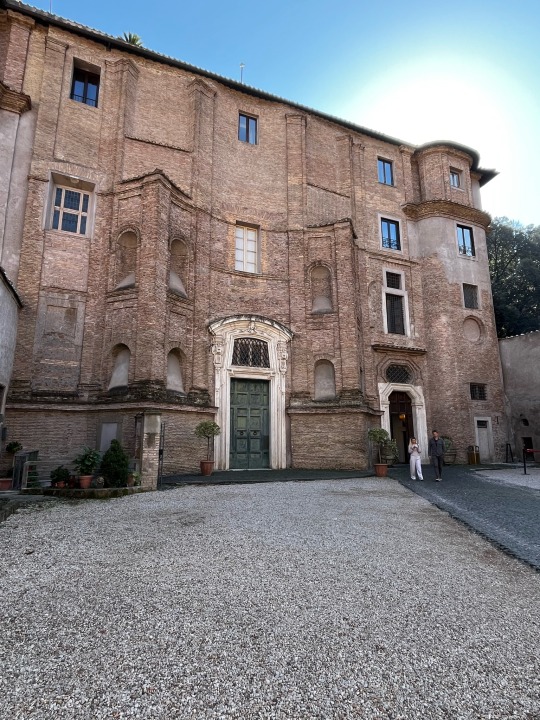
This is the church and monastery of Santa Maria dei Sette Dolori. It was designed by Borromini in 1643 for Donna Camilla Savelli Farnese. It was never finished. As the Farnese fortune declined so did the church funding. The monastery continued for many years and was used to hide Jews during the Holocaust. Today it is a hotel that carries her name, Hotel Donna Camilla Savelli. It is a curiosity because the entrance to the hotel is also the entrance to the church, which still exists.

The church vestibule copies the design of the small baths at Hadrian’s Villa, which we saw yesterday.

And the church is quite spectacular behind that drab exterior. The hotel looks very fancy too!

This is noted to be “the smallest house in Rome”.

This seemingly mundane looking church, St Francis on The Riverbank contains an exquisite Bernini statue. St Francis of Assisi is said to have spent time in the monastery attached to the church The church also contains what is believed to be the only portrait of the Saint, though its authenticity is in question.

Blessed Ludovica Albertoni was the last sculpture that Bernini did without assistance from his workshop. The subject was a Roman noblewoman who joined a convent after the death of her husband and was known for her good works amongst the poor of the city. She became a saint and this is the altar dedicated to her.
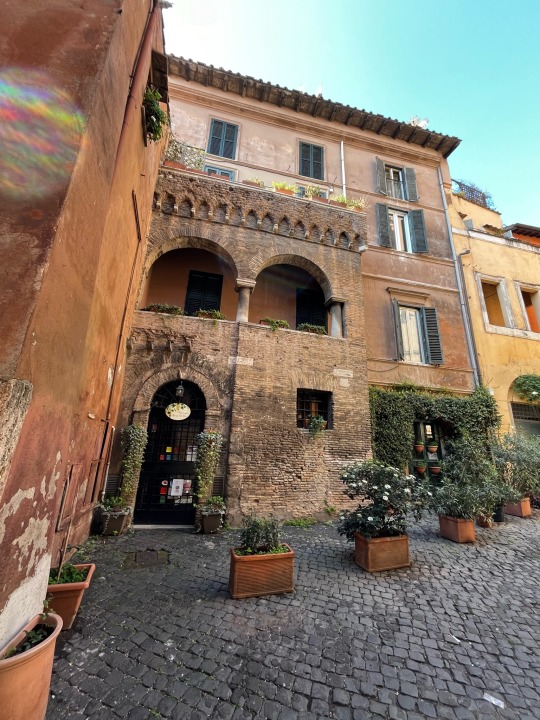
This restaurant, which I plan to try, is Spirito diVino. The building dates to 1035, when it was one of the early synagogues in Trastevere.

And most important of all, a Gelateria. This one, Fior di Luna, jumps into second place on my list of top Gelateria. The flavor and texture were perfect. The portions were smaller than usual, but that was offset by sugar cones, which are way better than the usual wafer cones. The master, Eugenio Morrone is an artist of the craft!
3 notes
·
View notes
Photo
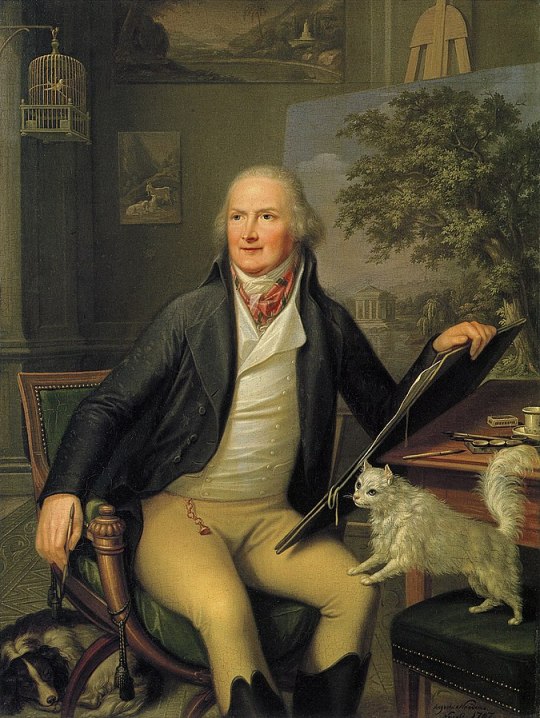
Augusto Nicodemo - Portrait of Jacob Philipp Hackert in His Studio, Naples - 1797
oil on canvas, height: 55.8 cm (21.9 in) Edit this at Wikidata; width: 42.1 cm (16.5 in)
Alte Nationalgalerie, institution Berlin State Museums, Germany
Jacob Philipp Hackert (15 September 1737 – 28 April 1807) was a landscape painter from Brandenburg, who did most of his work in Italy.
Hackert was born in 1737 in Prenzlau in the Margraviate of Brandenburg (now in Germany). He trained with his father Philipp (a portraitist and painter of animals) and his uncle, before going to the Prussian Academy of Arts in Berlin in 1758. Later he traveled to Swedish Pomerania and Stockholm, at the invitation of Adolf Friedrich von Olthof, a Swedish government official and businessman. For a time, he lived with Von Olthof and painted decorative murals at his estate.
He spent from 1765 to 1768 in Paris with the Swiss artist Balthasar Anton Dunker, where he focused on painting in gouache. He met and was inspired by Claude Joseph Vernet, who was already famous as a painter of landscapes and seascapes, and the German engraver Johann Georg Wille.
In 1768 Hackert left Paris with his brother Georg, and went to Italy, basing himself mainly in Rome and Naples, where he produced many works for Sir William Hamilton. He travelled all over Italy, gaining a reputation as a talented landscape painter. He became famous everywhere in Europe due to his works for Catherine the Great, the cycle of paintings about Battle of Chesma, and Pope Pius VI.
In 1786 he went to work for Ferdinand I of the Two Sicilies in Naples. He advised on the creation of a painting restoration laboratory at the Museo di Capodimonte, suggesting the call from Rome to the court of Naples of the restorer Federico Anders and supervised the transfer of the Farnese collections from Rome to Naples. As court painter realised famous pictures of Caserta and the Royal Palace of Caserta, besides the paintings series of the Bourobon's ports. During this period he acted also as a secret informant of Russia, his contact being the Russian diplomat Andrey Razumovsky.
When Goethe visited Naples in 1786, he and Hackert became friends.
Hackert had settled in a house in Posillipo. The painters Salvatore Fergola and Salvatore Giusti (1773-1845) were among his pupils.
In 1799, when Naples was declared the Parthenopaean Republic, Hackert lost much of his royal patronage. He moved to Pisa and then Florence. He bought an estate in San Pietro di Careggi, near Florence, and he died there in 1807 and was buried in the so-called "Dutch garden" of Livorno. His remains were then moved to the actual cemetery of the Dutch-German Congregation.
He never married and lived a good part of his life with one of his brothers but he had affairs with some married women, and from one of them he probably had a daughter.
Goethe wrote the first biography of Hackert in 1811.
15 notes
·
View notes
Photo
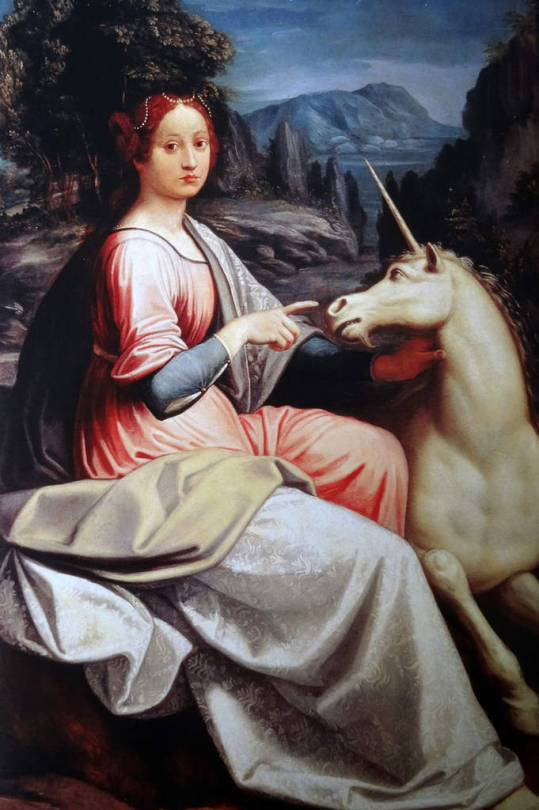
Giulia Farnese (1474 – 23 March 1524) was an Italian noblewoman, a mistress to Pope Alexander VI, and the sister of Pope Paul III. Known as Giulia la bella, Giulia was a member of the noble Farnese family, who were prominent leaders in the Italian regions of Parma and Piacenza. After marrying into the noble Orsini family in the Papal States, Giulia soon acquainted herself with, and initiated an affair with, the Spanish Cardinal Rodrigo de Borja. When the cardinal was elected Pope, Giulia continued the increasingly advantageous liaison, which enabled her to have her brother Alessandro made a cardinal, until losing Alexander's favor at the turn of the century.
Giulia spent most of her later years governing the castle of Carbognano, previously a property which Alexander had given to her husband. She died in 1524 in Rome at the residence belonging to Alessandro, who would later be elected Pope Paul III.
Lorenzo Pucci described her as "most lovely to behold". Cesare Borgia, the son of Alexander VI, described her as having "dark colouring, black eyes, round face and a particular ardor".
45 notes
·
View notes
Text
So is there like, some sort of naming convention that Berserk has? Because at first I thought they were mostly just made up fantasy sounding names, since a lot of the names were unfamiliar to me, at least for the main cast, but after some curiosity I’m noticing some characters at least do have their names based on things, at least by my assumption
In Renaissance Italy, there was an influential family called the House of Farnese (which would also explain why Farnese’s family has Italian sounding names), Schierke is the name a town in Germany, Casca was one of the assassins of Julius Caesar, and Serpico was the name of a movie in the 70s, and also the name of a famous police officer, Frank Serpico (though I’m not sure about that one since it sounds way too recent compared to the others, but you never know). I’m not sure for everyone else though
So like, is the naming convention European names (though mostly for relatively minor characters), and then historical European people or places?
This doesn’t apply for people like the Kushan, who really don’t seem to be European inspired (though the empire does seem to be named after a real Kushan Empire)
#maybe this is a dumb question but I still would like to know#just out of curiosity’s sake#and also because I don’t know what the other names are based on#this whole rabbit hole started with Farnese#and me wondering why her family had such Italian sounding names while hers didn’t really#so I was looking up if Farnese was an Italian name and found that it was an Italian family#then I got a bit curious as to the rest#berserk#schierke#casca#serpico#farnese de vandimion#questions#random stuff
7 notes
·
View notes
Text
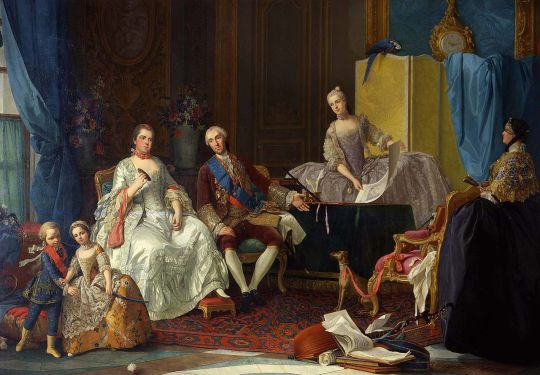
"The Family of Philip, Duke of Parma", 1755, Guiseppe Baldrighi, Galleria Nazionale, Parma.
Felipe de Borbón y Farnesio was the Duke of Parma from 1748 to 1765, and also the subject of one of my favourite portraits of the whole 18th century (from a set of 3, I will post those another time). The second son of King Philip V of Spain and Elisabeth Farnese, he became the Duke of Parma, that had been ruled by his mother's family for generations, via the Teatry of Aux-la-Chapelle in 1748, founding the House of Bourbon-Parma.
In this portrait we can see Philip sitting next to his wife Louise Elisabeth of France, the eldest daughter of Louis XV of France. They didn't have happy marriage, and she died of smallpox in 1759 at 32 years old.


Standing behind them there's their daughter Isabella of Parma, here wearing a lilac robe de cour, she would later marry Marie Antoinette's older brother, Holy Roman Emperor Joseph II, and would become very close (some people think that suspiciously close) to her sister in law Maria Christina. She died of smallpox after a difficult birth followed closely by two miscarriages at the age of 21.

At the front there are the Ferdinand (later Duke of Parma) and Maria Luisa (future wife of Charles IV and then Queen of Spain, yeah her cousin because of course).
At the front there's Ferdinand and Maria Luisa (aren't they the CUTEST?!). Both of them were born in 1751, and she's keeping his toy sword away from him, playing and pissing him off, like all siblings should. Ferdinand would become the Duke of Parma in 1765 at 14 years old and be later married to his bother in law's sister Maria Amalia of Austria. In 1801 he ceded the Duchy of Parma to France in the Treaty of Aranjuez.
Maria Luisa of Parma would become the Queen of Spain since she married Charles, then Prince of Asturias in 1765. He was mainly interested in hunting and mechanics and she in state affairs, so she became an influential and dominant figure in court. If this telenovela is not already sad enough for you, her father died unexpectedly in 1765 in Alessandria after having accompanied her to sail for Spain to be married to the Infante Charles.

There's also the profile figure of Marie Catherine de Bassecourt y Thieulaine the children's governess. She was a maid of honour of Phiilip's mother Elisabeth Farnese, and she joined Maria Luisa when she went to Spain and remained in the Spanish court since then. In 1765 Philip gave her the title of Marchese of Borghetto, thanking her services and merits.
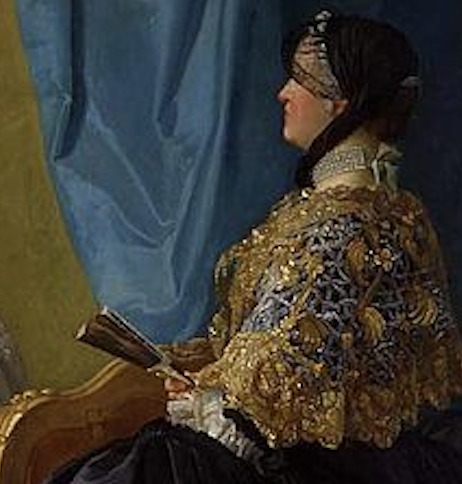
And finally, some pets and music. Didn't find anything about the dog nor the bird BUT I love them both. Especially the super fancy collar.
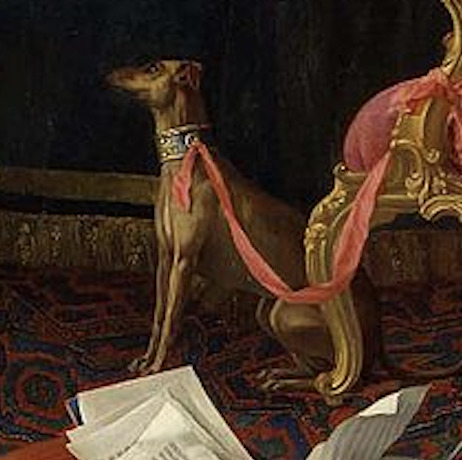


#1750s#1755#italy#spain#parma#duke of parma#guiseppe baldrighi#philip duke of parma#menswear#womenswear#spanish nobility#portrait#family portrait#art#18th century art
53 notes
·
View notes
Photo

Dorothea Sophia of Palatinate-Neoburg (1670 - 1748), Duchess of Parma. After Giovanni Maria delle Piane.
#ducato di parma#ducato di parma e piacenza#farnese#casato di farnese#casa farnese#duchessa di parma#italian aristocracy#kingdom of italy#german aristocracy#dorothea sophia of palatinate neoburg#house of wittelsbach#Giovanni Maria delle Piane
5 notes
·
View notes
Photo





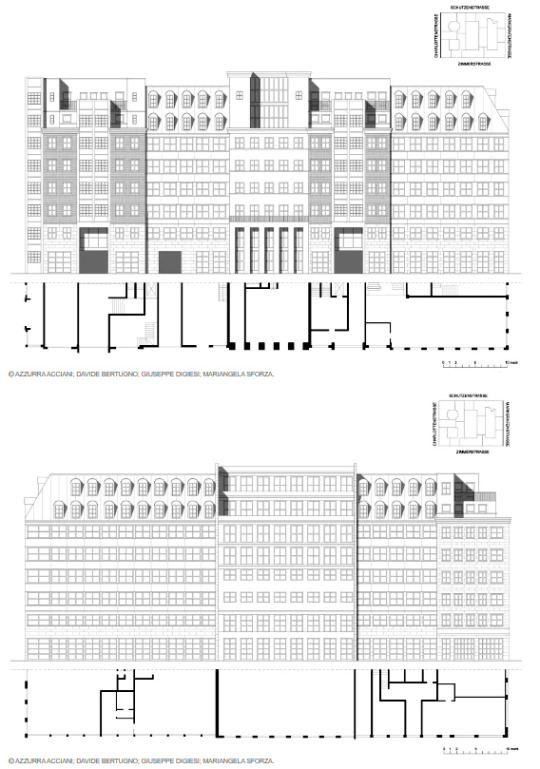
“Quartier Schützenstraße”, Charlottenstraße 16, 10117, Berlin, Germany [1994-1997] _ Architect: Aldo Rossi _ Photos by Spyros Kaprinis [27.01.2023].
“Situated nearby Checkpoint Charlie, a framed opening in the wall that used to split Berlin in two, the block is defined by the Schützenstrasse, Markgrafenstrasse, Zimmerstrasse, and Charlottenstrasse. The individualized houses signal individual plots but the total number of facades exceeds the number of houses standing independently of each other. While two of the buildings are reserved exclusively for residential apartments the rest provide for a mixture of residential and commercial use. The Quartier Schützenstrasse is a collage of icons and archetypes, with several obvious references to other Rossi buildings as well as historical references. Schützenstrasse 8 is a copy of the courtyard facade of the Palazzo Farnese in Rome, built in 1516 by Antonio Sangallo, that was modified by Michelangelo. The courtyard facade copies three of the centerline of windows of the Palazzo Farnese.
The intense colorfulness, inspired by the colors of antique architecture, tie the block together and draws attention to the allotment structure, which distinguishes the individual houses. Rossi used particular colors for particular facade materials; the more “artificial” the material, the more “vivid” the color. Blaring green and bright red signal aluminum. Muted colors; egg yolk yellow, carmine red, and cornflower blue are all stucco. The earthy tones shading into red-brown or yellow indicate bricks. The pale facades are two kinds of natural stone; light and dark gray, sand and pink. The silver-grey sheet metal stays as is. The urge towards a multiplicity of forms is unmistakable, the efforts beyond variations in color and material impressive. The varying window shapes, the appointment of the attics, the plastic development of the facades through extroverted and reticent sections, through sills and parapet; the sometimes expressly horizontal, other times explicitly vertical division of the mostly axial-symmetric facades; and finally their own, lightly staggered order all contribute to this effect.
The great pains Rossi took with the design of his city-within-a-city were only initially devoted to the plausibility of its lots structure. Rather, the ‘city’ was mainly dedicated to what he called a monument, so that it may have sovereignty over its use, just as it is sovereign over its environment. — Mathias Remmele Aldo Rossi died on September 4, 1997, a day before the unveiling of the ‘Palazzo Farnese’ façade; planned as an event to honour Rossi, it became a farewell address.”
https://dac.dk/en/knowledgebase/architecture/quartier-schuetzenstrasse/
https://divisare.com/projects/340790-aldo-rossi-giuseppe-digiesi-mariangela-sforza-azzurra-acciani-davide-bertugno-aldo-rossi-quartier-schutzenstrasse
#Quartier Schützenstraße#Charlottenstraße 16#Berlin#Germany#Aldo Rossi#1994#1997#Spyros Kaprinis#2023
12 notes
·
View notes
Text
──────────────────────
𝔉𝔞𝔪𝔦𝔩𝔶
contains: the characters and the family they'd grow up in if they were in a modern au where they were normal kids. imagine them as 10-11 years old in this.
──────────────────────

⋆*・゚: :✧*⋆ ・゚
— griffith
he'd be a good kid. i feel like it'd just be him and his mum. id say his mum would be this kind, gentle and kind of clumsy woman. she'd be working for the majority of the day to try and keep up with the expenses for herself and her kiddo, so griffith would likely take it upon himself to do thinks like cooking and cleaning to lighten her burden and pass time. she'd feel bad for him having to do all this, but he really doesn't mind because as long as she's there to eat with him and tuck him in he's okay. he'd also try his best at school and to stay out of trouble so she doesn't have any worries.
she'd be understanding, not too doting but not too harsh either. she'd correct his manners and behaviour if needed, but she would also always be his number one supporter.
happy mother to son relationship tbh it makes me happy to think about.
──────────────────────
— guts
he'd be the whiny younger brother. he'd have two mums and an older pre-teen/ teen sister. i feel like his mums would be the carefree, badass types and he would bicker with his sister a lot. one of his mums would definitely be a mechanic. he'd be the typical kid that would go out and play with the neighbourhood kids, ate rocks and grass, climbed trees, all of that.
sure, it'd be rough living in a house full of girls, but i feel like it'd raise him to be a strong feminist. and i really mean strong. his parents would be the types to call him "little squirt" and all of that. he'd just be that annoying brother, yk?
so his home would always be loud and never dull. his sister yelling about if anyones seen her stuff, one of him mums running around and the other in her own happy world while cooking.
──────────────────────
— judeau
he'd be the understanding and mature older brother. i think he would have two younger sisters, one around 6-8 and another that was still an infant. he'd have a mum and dad, his mum would be this sweet lady who always smelt like freshly baked and his dad would be like a business man or something. i feel like his mum and dad would be opposites, his dad would care for his kids but would be really awkward and wouldn't know how to show it so he'd accidentally seem a bit cold, wheras his mother would be understanding.
i think judeau would care for his siblings like a lot, he'd be a bit protective when it came to them as i feel like he'd like to help care for his siblings a lot to help his parents out. as i result, his sisters became extremely attached to him too.
──────────────────────
— casca
i think casca would just have a baby brother that's around 3, her mum, and her dad. i find it funny to think that the brother likes to try and copy everything she does so they do like everything together and became inseparable. i just find that thought really cute tbh.
her parents would just be normal and caring parents, telling her and her brother not to stay out too long when they go out exploring in the woods together, because then the 'wicked wolf' would eat them.
i also like to think that they'd end up meeting and playing with guts and griffith in the woods. griffith would be the one to start crying if anyone got hurt, guts would complain about no one having any, well, erm.. guts, and casca would be chasing her brother around so he doesn't get lost.
──────────────────────
— farnese
she would definitely have two older brothers that were extremely over protective. not in the way they'd be mean to her, but instead to literally anyone else that was around her that they didn't like, which was kind of everyone.
her parents would comment and joke about it, but they more or less let them be because there wasn't really anything to worry about.
i feel like she'd be a sensitive kid, so she'd cry really easily. meaning that if one of her brothers made her cry, they'd end up feeling extremely guilty and doing everything to make sure she forgave them, but she always did even without the chocolate and sweets. but if it was someone else, they got their teeth knocked out.
──────────────────────
— serpico
he'd be an only child for the majority of his life. i think it'd just be a normal small family with him and his parents. and i know i said i was imagining them as around 11 in this, but i feel like when he was around 15 he'd just randomly get a baby sister. i don't think he'd know how to react, but slowly he'd end up parenting her instead because of how she was always with him.
his parents would laugh about how he was being more of a parent to her than they seemed to be and that he was stealing their jobs, but i think they would have been happy to see him become so attached to someone apart of their family and take having a sibling quite well.
i think they're doubts would have been because he was naturally a distant and quiet child even when they tried to involve him with things, so serpicos little sister would have ended up bringing the entire family closer.
──────────────────────
#berserk#kentaro miura#Serpico berserk#farnese berserk#casca berserk#guts berserk#griffith berserk#berserk manga
33 notes
·
View notes
Text
Explaining One of VTMB Paintings (part 15)
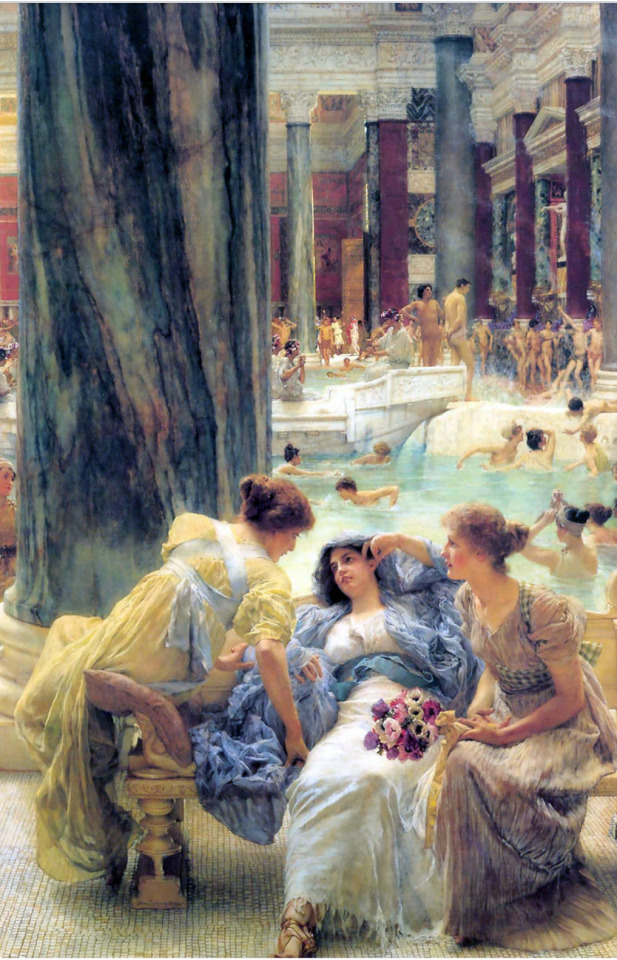
The Baths of Caracalla, oil on canvas (1899) by Sir Lawrence Alma-Tadema
Sir Lawrence Alma-Tadema(Jan 8 1836- Jun 25 1912) was a Dutch painter born in Dronryp , Netherlands and later became a UK denizen(an old legal status were you were able to own land and like in the UK without being a Citizen but still enjoying most of the rights). His art styles include both Romanticism (which this painting is) and Neoclassical.Before 1860s many of his works were of Merovingian subjects(Merovingian Dynasty was a Frankish(Germanic people who lived in what’s now part of Modern day France) ruling family in power from the mid 5th century to 751). His painting The Clotilde and the Tomb of her Grandchildren [1859 ](see below) is an example of Merovingian subject matter in a NeoClassical style. Despite his foundness Merovingian subject was not very popular on the international art market so he switched to painting focused on more popular subjects to depict in his artwork mostly focused on as historic/ ancient Egyptian, Roman and Greek subjects and events.

The Clotilde and the Tomb of her Grandchildren, oil on canvas (1858) by Sir Lawrence Alma-Tadema
Romantic art focused on emotions, feelings, and moods of all kinds including spirituality, imagination, mystery, and fervor. The subject matter varied widely including landscapes, religion, revolution, and peaceful beauty. The brushwork for romantic art became looser and less precise. The great Romantic artist Caspar David Friedrich summed up Romanticism saying "the artist's feeling is his law".
The Baths of Caracalla is a real Roman public bath built in Rome, Italy (the second largest in the city) sometime between 212 AD and 217 AD and was in operation until around 537 AD when it fell into disuse. The paining shows the historical imagination of what the baths would have looked like during the height of its popularity as it would be a major social space public space.
Historically Roman public baths acted as community centers where free and included access to a wide verity of atonal features such as gymnasiums for men to exercise; statues, murals and other public works of art; restaurants to buy multiple types of food and even a library that allowed everyday Roman citizens access to literature works they wouldn’t be able to offers to buy. Roman Public baths acted as not only bath houses but as a Library, gym, spa, restaurant and public art gallery. The waters of the baths were heated by a hypocaust, a heating system where coal and wood is burned under the ground.

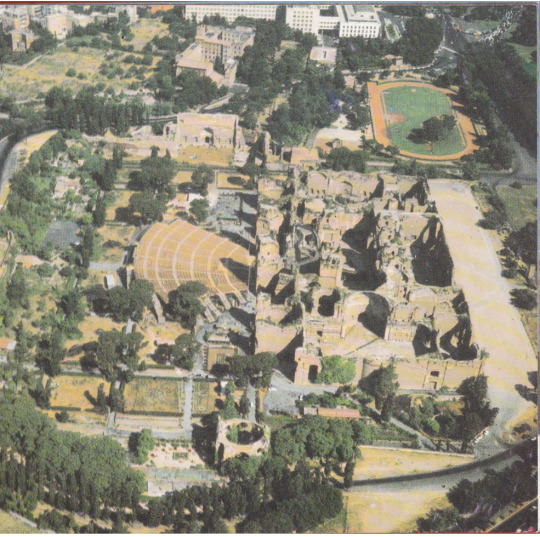
The baths were most likely built by emperor Septimius Severus (part of the Severan Family) as they are located in the southern part of Rome where during that time members of Severan family were known to commission a number of public works in that specific area of the city for political favor. The site the baths were built on where originally part of a Garden estate known as horti Asiniani by Gaius Asiniani Pollio during the reign of Augustus( first emperor of Rome 63 BC to 14 AD, so about 200 to 260 years before the construction of the baths). The Garden was home to a number of sculptures such as the Farnese Bull which were kept as part of the public art displays of the baths when they were in use. During the height of its popularity the baths are estimated to have a daily capacity of 6,000 to 8,000 visitors a day.

Farnese Bull, marble sculpture (2nd century BC) by Apollonius of Tralles
Even after falling into ruin the Caracalla baths still found use as in the 14th century a Christian pilgrim site was set up near by due to the proximity to the Church of Saint Nereo e Achilleo( built facing the baths in the 4th century) and was used by the pilgrims as their main water source. But in 537 AD during the war of the Gothic war the city’s water supply was cut by Vitiges of the Ostrogoths and the baths were once again abandoned.

During the 6th and 7th century the baths were still in the very sparely populated area of Rome and were used to burry pilgrims who died in the xenodochium ( hospital specifically for treatment of foreign pilgrims) of the Church of Saint Nereo e Achilleo. Then starting in the 12 century the baths were used as a quarry for stone and decorative masonry that were often used in the construction of churches. In the 15th century Pope Pius II used stone from the baths in the construction of the Loggia of the Benediction (fancy decorative balcony used by the Pope) at St Peters Basilica, Vatican City. (See photo below)
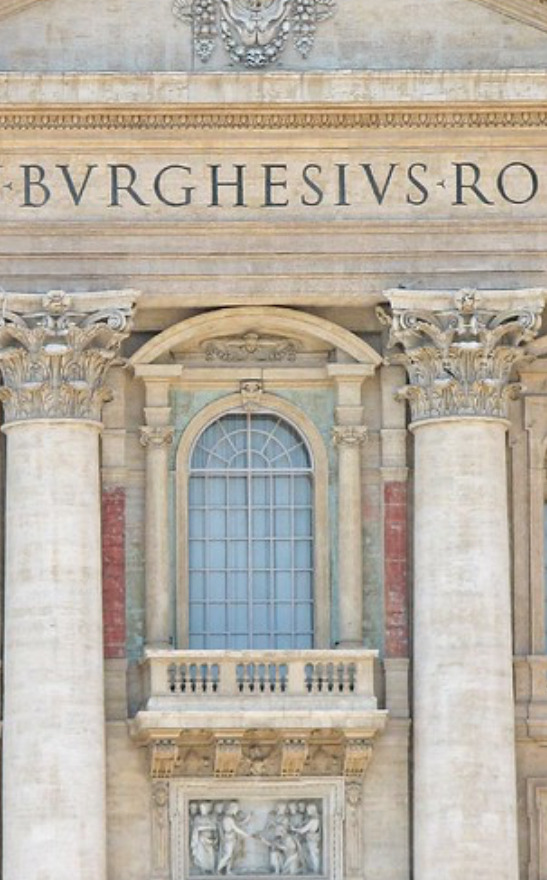
it wasn’t until the 16th and 18th century when interest in restoring the Baths as a historic site began. With the excavation of the baths beginning in 1824 by Count Egidio di Velo.
The Baths of Caracalla have been a popular subject of a number of different art works over the years by a wide number of artist who ether are depicting historical scenes of artist imaginations of the baths in its prime or capturing architectural beauty that remained even after it fell into ruin. (see examples below)

Baths of Caracalla Rome: interior of the Tepidarium, watercolor (1845) C.R. Cockerell and assistant Jackson used in lecture of architecture. Image based on illustration based of detailed restoration done on the baths found in a book published by French architect G.A Blouet in 1828.

Interior of the Baths of Caracalla, print if etching with watercolor and gouache(circa 1780) by Swis painter and engraver Abraham-Louis-Rodolphe Ducros.
#vampire the masquerade bloodlines#VTMB#explaining one of vtmb paintings#art history#romanticism#The baths of Caracalla#Ancient Roman#Sir Lawrence Alma-Tadema
1 note
·
View note